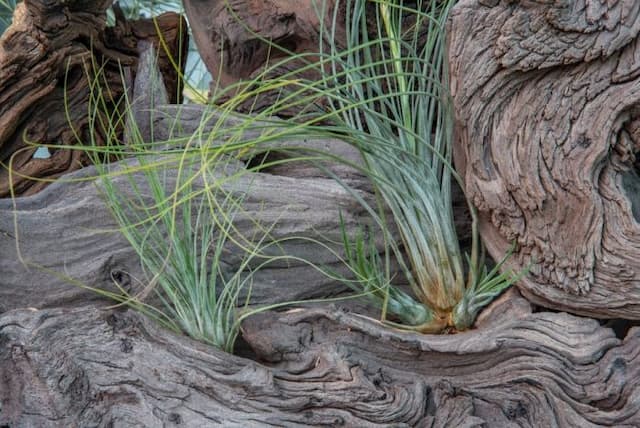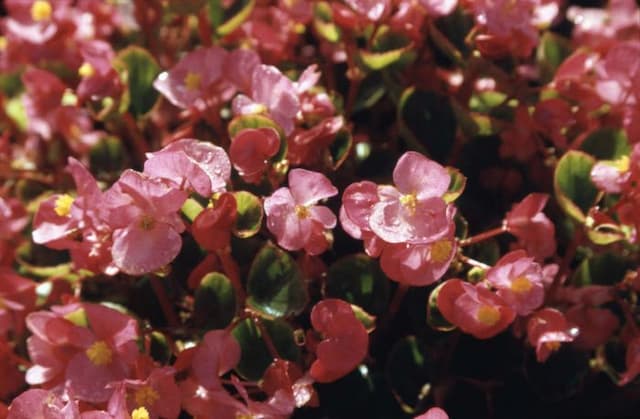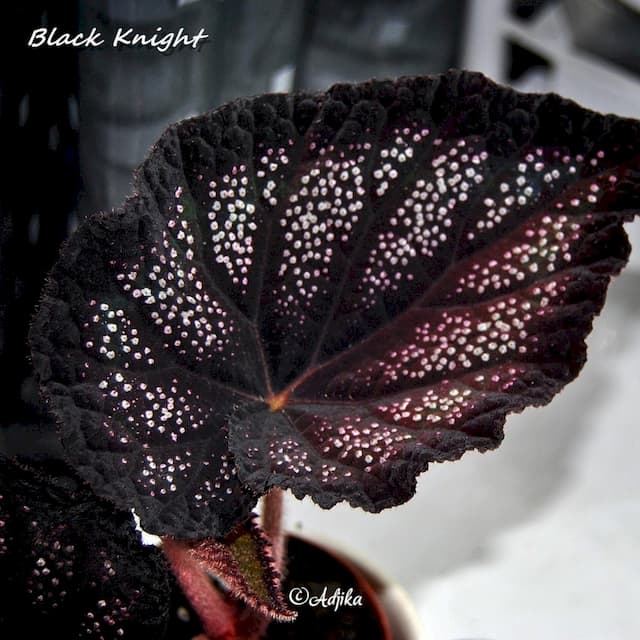Eyelash Begonia Begonia 'Tiger Paws'

ABOUT
Begonia 'Tiger Paws', commonly known for its striking foliage, features unique leaves that are the highlight of its appearance. The leaves exhibit a distinctive color pattern, reminiscent of a tiger's coat, which likely inspired the plant's name. They have a green base color with contrasting markings in shades of red or brown, creating the appearance of paw prints across the leaf surface. The shape of the leaves can be described as broadly ovate with a somewhat asymmetrical base, and they often possess a slightly wavy or serrated edge that contributes to its textured look. Begonia 'Tiger Paws' leaves may appear somewhat cupped, giving them a dimensional and full-bodied appearance, enhancing the plant's ornamental value. Additionally, the foliage has a subtle sheen that catches light, adding to the visual interest of the plant.
About this plant
 Names
NamesFamily
Begoniaceae.
Synonyms
Tiger Paws Begonia, Eyelash Begonia.
Common names
Begonia 'Tiger Paws'.
 Toxicity
ToxicityTo humans
Tiger Paws Begonia is generally not considered toxic to humans. However, some people may be sensitive to begonias and may experience irritation or an allergic reaction if they handle the plant without gloves. Ingesting parts of the plant is not recommended, as it can cause mild gastrointestinal discomfort, such as nausea or vomiting, but it is unlikely to cause severe poisoning.
To pets
Tiger Paws Begonia is considered toxic to pets, particularly cats and dogs. If ingested, it may cause symptoms such as drooling, vomiting, and difficulty swallowing due to irritation of the mouth and gastrointestinal tract. In some cases, it may also lead to kidney failure or other serious health issues, so it is important to keep this plant out of reach of pets and seek veterinary care if you suspect your pet has ingested any part of it.
 Characteristics
CharacteristicsLife cycle
Perennials
Foliage type
Evergreen
Color of leaves
Green
Flower color
Pink
Height
6 inches (15 cm)
Spread
12 inches (30 cm)
Plant type
Herb
Hardiness zones
10
Native area
Central America
Benefits
 General Benefits
General Benefits- Easy to Care For: Begonia 'Tiger Paws' is a low-maintenance plant, perfect for beginners or those with a busy lifestyle.
- Attractive Foliage: It features eye-catching leaves with unique coloration and patterns that add aesthetic interest to any room.
- Compact Growth: Its small size and growth habit make it ideal for limited spaces like apartments and small offices.
- Long Flowering Season: This plant can bloom for an extended period under the right conditions, providing long-lasting beauty.
- Promotes Well-being: Having plants around can boost mood and create a calming environment in the home or office.
- Versatile Decoration: It can be used in a variety of settings, from tabletops to hanging baskets or terrariums, enhancing the decor.
 Medical Properties
Medical PropertiesThis plant is not used for medical purposes.
 Air-purifying Qualities
Air-purifying QualitiesThis plant is not specifically known for air purifying qualities.
 Other Uses
Other Uses- Terrariums: Due to their small size and preference for high humidity, Tiger Paws can be used to create lush landscapes inside terrariums, providing both aesthetic appeal and a suitable environment for humidity-loving reptiles and amphibians.
- Photography: The intricate patterns on the leaves of Tiger Paws can serve as a unique subject matter for macro photography, helping photographers to practice focusing techniques and explore plant macro imagery.
- Education: Tiger Paws can be used in classrooms or educational programs to teach about plant care, propagation, and the diversity of leaf patterns in the plant kingdom.
- Culinary Presentation: Although not edible, the distinct leaves can be used for decorative plating in culinary arts to add a vibrant backdrop to dishes, without consuming the leaves.
- Fashion Inspiration: The striking contrast of colors in Tiger Paws leaves can inspire patterns and designs in fashion, leading to nature-inspired clothing and accessories.
- Art Projects: The leaves can be used as natural stamps or stencils for creating patterns on paper or fabric, providing an organic touch to art pieces.
- Seasonal Decorations: During autumn, Tiger Paws can be integrated into fall-themed decorations due to their coloration, complementing the traditional autumnal palette.
- Botanical Illustration: Artists can utilize Tiger Paws as a subject for botanical illustration, capturing their unique appearance and contributing to the documentation of plant varieties.
- Color Therapy: The vibrant and contrasting colors of the Tiger Paws leaves can be used in color therapy sessions to create an environment of energy and stimulation for the participants.
- Wedding Decor: Incorporating Tiger Paws in wedding bouquets or table arrangements can provide an exotic and textured look to the floral compositions.
Interesting Facts
 Feng Shui
Feng ShuiThe Eyelash Begonia is not used in Feng Shui practice.
 Zodiac Sign Compitability
Zodiac Sign CompitabilityThe Eyelash Begonia is not used in astrology practice.
 Plant Symbolism
Plant Symbolism- Beware - Begonia 'Tiger Paws', like other begonias, often carries the message of caution or warning, hinting that the situation may need careful review.
- Harmony - The symmetrical pattern of the leaves on this plant can symbolize balance and harmony in life.
- Uniqueness - With its distinctive spotted foliage, 'Tiger Paws' can represent individuality and the beauty of being different.
- Gratitude - Given as a gift, begonias may express appreciation or gratitude towards someone.
 Water
WaterTiger Paws Begonia prefers to be watered when the top inch of soil feels dry to the touch. Typically, this means watering approximately once a week, but this can vary depending on environmental conditions such as temperature and humidity. When watering, use room temperature water, and water the plant thoroughly until water starts to drain from the bottom of the pot. Always ensure excess water is drained away to prevent root rot. It is better to err on the side of underwatering than overwatering; you might use around 16-24 onzes of water on average, but always adjust based on the plant's response and the soil's moisture level.
 Light
LightTiger Paws Begonia thrives in bright, indirect light away from direct sunlight which can scorch the leaves. A spot near an east or north-facing window would be ideal, where it can receive moderate light without being exposed to the harsh afternoon sun. If only artificial light is available, ensure it's a full-spectrum light source to support healthy growth.
 Temperature
TemperatureThe Tiger Paws Begonia prefers temperatures between 60°F and 75°F. Do not expose the plant to temperatures below 50°F as cold drafts can harm it. Avoid placing your begonia near heat sources or drafty windows, as it's sensitive to sudden temperature changes.
 Pruning
PruningPrune Tiger Paws Begonia mainly to remove any dead or yellowing leaves and to promote bushier growth. Light pruning can be done throughout the year as needed, but the best time for more extensive pruning is in the spring or early summer. This allows the plant to recover and grow back more vigorously during its active growing period.
 Cleaning
CleaningAs needed
 Soil
SoilFor Eyelash Begonia, use a well-draining mix of peat moss, perlite, and pine bark. A slightly acidic to neutral pH of 6.0-7.0 is ideal for this plant.
 Repotting
RepottingEyelash Begonia should be repotted every 2-3 years or as it outgrows its container to ensure continued growth.
 Humidity & Misting
Humidity & MistingEyelash Begonia thrives best at a high humidity level, ideally between 50%-60%.
 Suitable locations
Suitable locationsIndoor
Place Eyelash Begonia in bright, indirect light with high humidity.
Outdoor
Grow Eyelash Begonia in shade or part-shade, shelter from harsh weather.
Hardiness zone
10-11 USDA
 Life cycle
Life cycleBegonia 'Tiger Paws' begins its life cycle as a seed, germinating in warm, moist soil. Once sprouted, it enters the vegetative stage, growing characteristic angel wing-shaped leaves with a pattern resembling a tiger's paw, giving rise to its common name. During its growth, Begonia 'Tiger Paws' prefers bright indirect light, and will produce more pronounced leaf markings in such conditions. This plant then reaches maturity and can produce clusters of small flowers, though it is primarily grown for its striking foliage. After flowering, it can set seed, but it is often propagated through cuttings to maintain specific cultivar traits. The life cycle continues as these cuttings root, grow, and eventually become mature plants themselves.
 Propogation
PropogationPropogation time
Spring-Summer
Propogation: Begonia 'Tiger Paws', also commonly known as Eyelash Begonia due to the fringe of hairs on the edge of its leaves, is a plant that can be propagated quite easily through leaf cuttings, which is the most popular method. To propagate Begonia 'Tiger Paws' through leaf cuttings, a healthy, mature leaf is cut from the parent plant using a sharp, sterilized knife or scissors. A portion of the leaf stem, about 1 to 1.5 inches (approximately 2.5 to 3.8 cm) long, should also be included. This leaf, with its petiole, is then inserted into a mixture of moist potting soil and perlite or vermiculite. Covering the pot with a plastic bag to maintain high humidity levels can hasten root development. Within a few weeks, the leaf should start to root, and new growth will eventually form at the base of the petiole. After new plants have developed a robust root system, they can be transplanted into individual pots to grow on their own.







![Begonia [Allure]](/_next/image?url=https%3A%2F%2Fplants-admin.emdemapps.com%2Fimages%2Fplants%2F%2Fimages%2F604b5b9006ab9.png&w=640&q=75)

